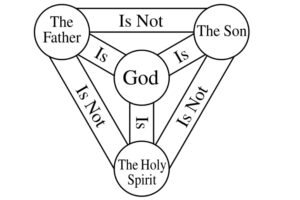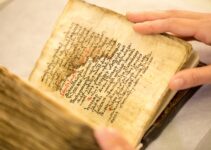Table of Contents
Introduction to the Holy Trinity
You’ve likely heard the term “Holy Trinity” if exposed to Christian theology. This complex yet fundamental doctrine, the Holy Trinity, is a foundational concept in Christianity, encapsulating the nature of God as being simultaneously three separate entities while being one single essence. However, understanding the Holy Trinity has always been a matter of much debate and contemplation, as this mystical concept goes beyond the grasp of conventional human logic, requiring a deep immersion into theological inquiry.

The Trinity in the Bible
The Trinity’s concept is intriguing because the term “Trinity” itself is not explicitly stated in the Bible. However, the idea of the Trinity in the Bible is inferred from several passages that collectively imply a triune God. For instance, the baptism of Jesus in the New Testament is a significant moment where all three persons of the Trinity—the Father, Son, and Holy Spirit—are distinctly mentioned. Thus, forming the Biblical basis of the Trinity. The aspect of The Trinity and the mystery of God’s revelation in the Bible only adds to the concept’s complex understanding, threading a line that ties together the Old and New Testaments.
Historical and Theological Context
The understanding of the Trinity in early Christianity was less comprehensive than today. The historical development of the Trinity involved centuries of theological debates and discussions, with the concepts gradually taking shape over time. The Church Fathers’ interpretations, including the likes of Augustine and Athanasius, played a vital role in shaping the doctrines of the Trinity. These interpretations were a crucial part of understanding the Trinity and the early Church Fathers.
Trinity in Christian Doctrine
The Trinity in Christian doctrine is viewed as the bedrock of the Christian faith. The theological concept of the Trinity encapsulates the belief in one God who exists in three distinct persons: Father, Son, and Holy Spirit. Each person is God, yet they maintain their distinct personhood. These tenets form the crux of Trinity beliefs central to Christian doctrine for centuries.
Trinity Across Christian Denominations
Christianity comprises a vast spectrum of denominations, each with its unique interpretation and understanding of the Trinity. The concept of the Trinity in Christianity is a unifying theme across denominations, but the specifics may vary. For instance, the Trinity in Catholicism and Protestantism uphold the concept of a triune God but may differ in how the three persons interact. The Trinity in the Eastern Orthodox Church brings in another layer of understanding, emphasizing the unity of God in diversity.
The Trinity in Art
Art has always been a significant mode of religious expression, and the Trinity is no exception. The Trinity in Christian art and sacred art typically depicts the three persons of the Trinity in symbolic or metaphorical representations. These artistic depictions of the Trinity help us grasp the concept more palpably, providing insights into how different cultures and eras have visualized and interpreted the Trinity.
The Nature and Personhood of God in the Trinity
The concept of the Trinity directly informs our understanding of The Trinity and the nature of God. It’s crucial to grasp that while God is three persons in the Trinity, there is only one God, not three, affirming the unity of God. This understanding of the Trinity preserves the fundamental concept of monotheism within Christianity. Additionally, the Trinity also offers a profound insight into the personhood of God, with each person of the Trinity – the Father, the Son, and the Holy Spirit – possessing unique characteristics and roles.
The Holy Spirit in the Trinity
The Holy Spirit forms the third person of the Trinity. While the Holy Spirit is often the least understood person of the Trinity, it is entirely God, equal to the Father and the Son. In the Trinity, the Holy Spirit often embodies roles related to inspiration, guidance, and sanctification, underscoring its dynamic and active presence in the life of a believer.
The Incarnation and the Trinity
The Trinity and the incarnation are closely linked, with the second person of the Trinity, the Son, taking on a human form as Jesus Christ. The image shows how the Trinity operates in harmony for the salvation of humankind. This event also highlights the unique role of each person in the Trinity – the Father sending the Son into the world, the Son willingly becoming human, and the Holy Spirit empowering and guiding the entire process.
The Trinity in Christian Worship
Christian worship is imbued with references to the Trinity, affirming each person’s unique role within the Godhead. The Trinity and Christian worship are inseparably linked, with elements of the Trinity permeating all aspects of Christian spirituality and devotion. This highlights how the distinct persons of the Trinity are engaged in the worship and adoration of God.
The Trinity and Salvation
Christian salvation is intricately tied to the Trinity. In Christian belief, salvation is a work of the entire Trinity—the Father’s plan, accomplished by the Son and applied by the Spirit. This connection between the Trinity and salvation showcases the cooperative work of the Triune God in the process of redemption, highlighting the profound mystery of redemption and the extravagant grace bestowed on believers.
The Trinity and the Mystery of Faith
The Trinity is a central component of the Christian faith, impacting how believers understand God and their relationship with Him. The Trinity and the mystery of faith remind believers of God’s complex yet beautiful nature, which is beyond complete human comprehension. This concept invites Christians to engage with the divine mystery more profoundly, forging a connection beyond mere intellectual understanding to a journey of faith and trust.
Conclusion: The Divine Mystery of the Holy Trinity
The Trinity is a divine mystery that captivates theologians and believers alike. The more we delve into the concept, the more we realize the depth of its riches. The Trinity, in its complexity and wonder, truly reflects the magnificence of God, inviting us to continual exploration and discovery.
Frequently Asked Questions (FAQs)
- What is the Holy Trinity in Christianity? The Holy Trinity in Christianity refers to the doctrine that God exists as three persons – Father, Son, and Holy Spirit – yet is one God. This belief is foundational in Christianity and speaks to a complex understanding of God’s nature and character.
- How is the Trinity represented in the Bible? The Trinity is inferred from various passages throughout the Bible, particularly in the New Testament. While the term ‘Trinity’ isn’t used, references to the Father, Son, and Holy Spirit allude to the triune God concept.
- What is the significance of the Trinity in Christian faith and practice? The Trinity is central to Christian faith and practice as it encapsulates the understanding of God’s nature. This belief influences worship, prayer, and the knowledge of salvation. It’s a foundational belief that impacts nearly every other area of Christian faith and practice.
- How does the Trinity inform the Christian understanding of God? The Trinity informs the Christian understanding of God by presenting God as a unity in diversity. While God is one, he exists in three persons – the Father, Son, and Holy Spirit. Each person is fully God yet maintains a unique identity and role within the Godhead.
- What are the differences in understanding the Trinity across various Christian denominations? While all mainstream Christian denominations uphold the belief in the Trinity, the nuances of understanding can vary. Catholic, Orthodox, and Protestant churches all affirm the doctrine of the Trinity. Still, nuances may exist in how they understand the relationships within the Trinity, the roles of each person of the Trinity, and how this belief is lived out in worship and practice.
- What role does the Holy Spirit play in the Trinity? The Holy Spirit is the third person of the Trinity and plays crucial functions, including inspiring scripture, empowering and equipping believers, and being active in the world. While the Holy Spirit’s role is diverse, its work is always in unity with the Father and the Son.
- How does the Trinity relate to the Christian understanding of salvation? The Christian understanding of salvation is closely tied to the Trinity. Each person of the Trinity has a role in salvation—the Father plans, the Son accomplishes, and the Holy Spirit applies salvation to individuals. This understanding underscores the unity and cooperation within the Trinity in the work of salvation.


